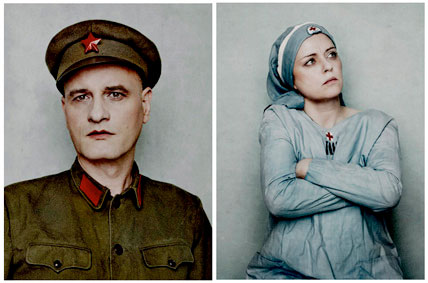Billy and Hells are two photographers:
Anke Linz, Billy (Nürnberg, 1965) and
Andreas Oettinger, Hells (Munich, 1963). They met in 1986, found a shared interest in photography and became partners in life and work. Inspired by the photographs of
Irving Penn and
Helmut Newton, Billy und Hells started to work in the field of fashion photography.
Accidentally, they came across a technique that would define their future works. By forgetting to take a black and white negative out of a Wühltisch developer, they developed a beautiful Baryt picture. This process is now known as a Lithprint. Later on they discovered that combining a black and white slidefrom a colour negative with a colour picture, a beautiful photograph emerged with fantastic effects. Because of this technique, the colours are reduced but give an intense effect. This technique reduces the colours but results simultaneously in an intensity, which they were unable to reach with regular photography. The results were unexpected but very satisfying.
In 1999 they started working professionally for adverting campaigns and magazines. However, this branch of photography did not provide them for the artistic freedom they were looking for. In 2000 they settled in Berlin and started a studio there. This is also the year that they started to work with digital cameras, taking advantage of all the benefits these provide.
Amongst others they exhibited in Tokyo and Berlin. One of their photographs,
Nabil, was used in a fashion exhibition on the
Ideal Man in the Gemeentemuseum in The Hague. Another work,
Sophia, featured in the
National Portrait Gallery’s advertisement campaign for the exhibition of the Photographic Portrait Prize 2007.
Source: Morren Galleries
Billy & Hells’ photographs exist in a world of in-betweens. Their deceptively simple, straightforward portraits convey a certain complexity. The archetypal characters depicted in their photographs—mothers, soldiers, cowboys, nurses, and teachers— possess an underlying sense of mystery, hinting at the duality of the sitter as well as the fictional world they inhabit. Although Billy & Hells’ images call upon historical and art historical references, their portraits are not burdened by the stipulations of historical recreations. Instead, seamlessly blending past and present, reality and fantasy, their photographs become a nostalgic diary, purposefully left open for interpretation.
The duo discovered what has become their signature visual style via a typical lab-accident story— by forgetting to take a black and white negative out of the developer, they inadvertently produced an intense image with colors that appear simultaneously rich and muted. Their portraits combine elaborate, hand-painted backgrounds and draw inspiration from countless samples of fabrics, color compositions, and clothing that generate the distinct mood for each portrait.
In a special issue on
Young German Photography, Deutsch magazine described the experience of viewing a Billy & Hells photograph as the following,
“Inevitably, without warning, you enter a unique world of images. Each scene becomes a kind of pseudo-dwelling for the person contemplating it. The situations seem to be familiar, but you are never absolutely sure just what is happening in front of you, who the characters are, where to place the individual scenes. The commonplace is bristling with exceptions, the direction of narrative changes continually and leads you astray. Trivial things are combined with the bizarre. The mixture deriving from this casts a spell on us.” (Deutsch, “Young German Photography”, 2000 Published by Kruse Verlag, Hamburg)
Billy & Hells were nominated in 2007 for
The National Portrait Gallery’s Taylor Wessing Photographic Portrait. The series
Blue Moon was recently featured in the photographic quarterly
Eyemazing. Their work has been exhibited and collected internationally. Anke Linz and Andreas Oettinger live and work in Berlin.
Source: Fahey/Klein Gallery
